I’m sure by now you recognize the importance of staying active on social media to promote your business.
Your Instagram marketing campaigns need to be a priority.
If you’re not using Instagram to reach your customers, there is a good chance your competitors are doing so. In fact, more than 70% of businesses in the United States are using Instagram.
Furthermore, 70% of hashtags on this platform are branded.
That’s why it’s so important for you to leverage your Instagram profile to connect with your current customers and target prospective consumers as well.
Believe it or not, consumers want to interact with brands on social media. We know that 80% of Instagram accounts follow at least one business profile.
If you’re getting lots of followers, that’s great. However, you need to learn how to convert your social media followers into customers, or your efforts won’t pay off.
But what about the consumers who don’t follow your business on Instagram?
They might be interested in your products, services, and content, but they won’t see any of your promotions if they’re not following your profile.
That’s where Instagram ads come into play.
Buying ads on Instagram will help give you a huge advantage over your competitors who aren’t willing to spend the money.
That said, any time you’re spending valuable marketing dollars, it’s important to make sure those efforts yield a high ROI. You don’t want to blindly buy ads without making sure they’re profitable.
If you’re new to Instagram ads or if your current ones need improvement, you’ll benefit tremendously from this guide.
I’ll explain how to drive sales with your Instagram marketing strategy, get more followers, and expand your reach. Here’s what you need to know.
Determine your marketing objective
Instagram is owned by Facebook. You’ll be using the same platform you used to generate leads with Facebook ads.
The first thing you’ll need to do is select your marketing objective:
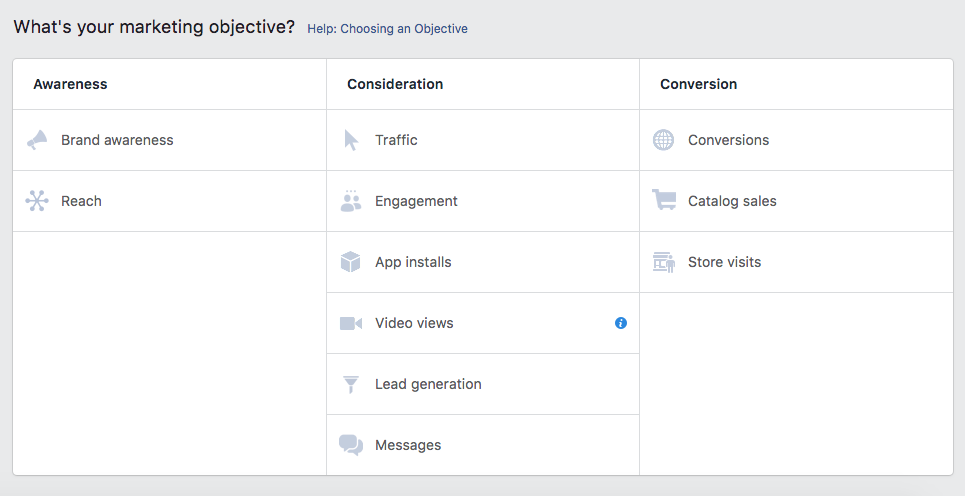
The goals are broken down into three main categories:
- awareness
- consideration
- conversion
Truthfully, there is no right or wrong answer here when it comes to making this selection.
Any choice can lead to profits. For example, if your goal is to generate website traffic, that traffic can eventually lead to conversions.
If you are trying to increase your brand awareness, extend your reach or generate leads, those campaigns can end up creating sales in the future.
But if you’re trying to get instant sales, you’ll want to select conversions, catalog sales, or store visits as your marketing objective.
These types of ads will have actionable CTAs to drive sales. But we’ll discuss that in greater detail shortly.
Again, your ads will be effective no matter what you choose. Everyone’s brand is different. Don’t expect your goals to mirror those of other companies.
If you have the budget, you can even run multiple campaigns with different goals to see which ones are the most beneficial for your business.
Then, you can continue running the most successful ones.
Identify your target audience
Next, you’ll need to determine the audience you want to target.
There are different approaches to this step, depending on the overall marketing goals of your company and each campaign.
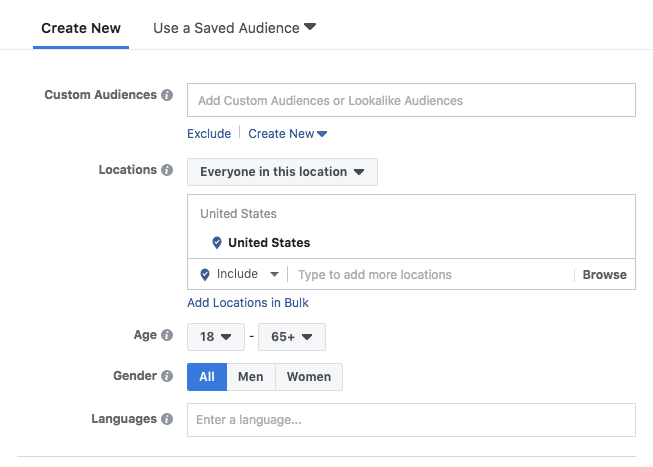
You’re able to select your audience based on factors such as:
- location
- age
- gender
- language
Again, this will change based on each campaign. For example, let’s say your brand sells sports equipment to consumers in the United States.
That doesn’t mean all your ads will be relevant to every location.
An ad that promotes a sale on surfboards won’t appeal to someone who lives in Colorado. Ads for women’s golf clubs should be seen only by, you guessed it, women.
I know this sounds basic, but you’d be surprised how often I see businesses make such simple mistakes. They try to target as many people as possible, which isn’t a profitable strategy.
Another cool feature you should keep in mind when you’re selecting your target market is the ability to create a custom audience.
This allows you to set your ads to reach users who have interacted with you before.
For example, a person who doesn’t follow you can still see one of your posts on the Instagram “explore” page, also known as the “popular page.” That’s a custom audience you could target.
You can also set a custom lookalike audience. These ads will target users similar to your current followers.
Set a budget
I don’t recommend spending every dollar in your marketing budget on Instagram ads, especially if this is your first time using this strategy.
Get your feet wet before you dive in head first.
Everyone’s budget is different. But let’s keep things simple for now and say that your company has allocated $5,000 to spend on Instagram ads.
That’s great.
However, it doesn’t mean you should dump all $5,000 into one campaign. Mix it up.
As I said before, you’ll want to experiment to see which types of ads benefit your brand the most based on your goals.
Try running five campaigns at $1,000 each.
Don’t run them all simultaneously. Not everyone who sees your advertisements will convert. But if they see three ads over the course of a couple of months, it might get the job done.
While it’s important for you to spend within your means, it’s worth noting that even small business owners are planning to increase their Instagram marketing budgets.
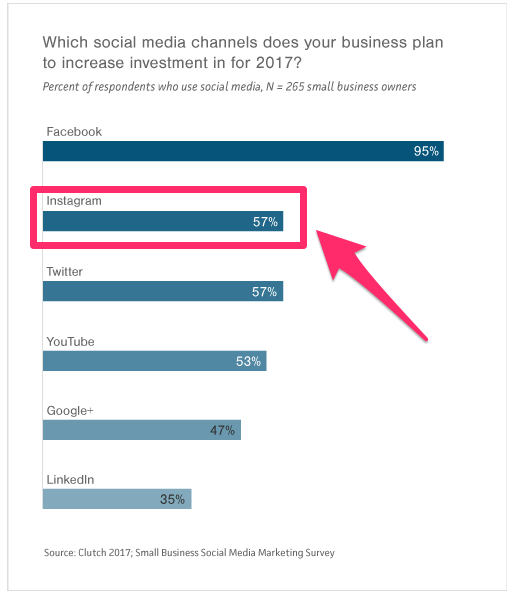
As you can see, Instagram is second only to Facebook in the list of all social media networks small businesses plan to spend more money on in the coming years.
If you don’t have the funds to spend much money on Instagram ads right now, you should budget accordingly for the future.
The last thing you want is to let your competitors beat you to new leads. Or even worse, lose your current customers to the competition because they ran ads and you didn’t.
Choose which types of ads you want to run
There are a bunch of different types of ads you can run on Instagram. That’s because the platform is versatile. These are all the options for you to consider:
- photos
- videos
- carousel
- stories
One of the best parts about Instagram ads is that your content appears naturally within the rest of the content seen by users.
Such posts are clearly labeled as sponsored ads, but they still look like any other content from any other account an Instagram user might follow.
For example, let’s say a user is browsing through the stories of the accounts they follow. If you run a story ad, your story will be presented between two stories posted by profiles they follow.
Sure, a user may recognize they’re seeing an ad. But that won’t necessarily stop them from consuming your content.
In fact, 60% of users say they use Instagram to discover new products. And 75% of that group follow through with an action after that discovery.
The action may not be a purchase—it could be a click to find out more. But that should give you a chance to get these users to convert.
Use an actionable CTA
Your CTA will have a big impact on how users react to the sponsored content they’re presented with.
Let’s assume you accurately selected your target market and your ad is being displayed to those interested in your product and willing to buy. How can you get them to convert?
Invite them to buy with action verbs. Get right to the point.
Check out this CTA example from a MeUndies advertisement on Instagram:
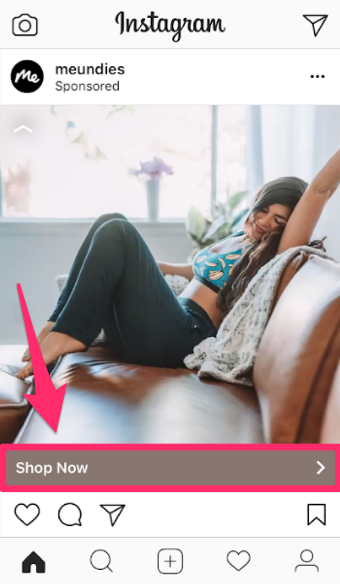
Shop now.
There is nothing ambiguous about this CTA. It’s much more actionable than something like “find out more information here.”
That type of CTA won’t drive sales.
But with a call-to-action such as “shop now,” users who see this advertisement will know exactly what to expect when they click on the button.
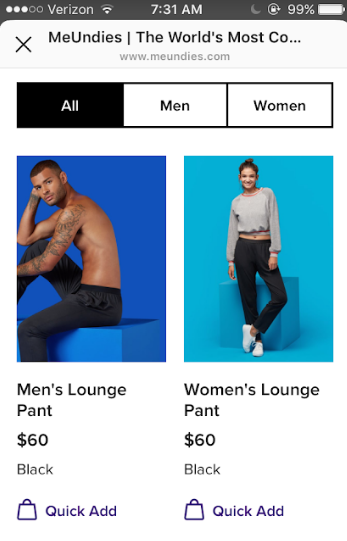
As expected, this CTA brings you directly to the brand’s ecommerce shop.
Take a look at this landing page to see how MeUndies is able to drive sales with its advertisement.
It’s very simple.
Since people are viewing these ads on their mobile devices, don’t try to cram too many products onto the screen at the same time.
Here, when users scroll, they see only two products at a time.
Now, take a minute to scroll back up to the original post. It featured a model wearing sweatpants.
Naturally, the first two products displayed on the landing page are sweatpants. It makes sense and should promote conversions.
Let’s say your Instagram advertisement is promoting a new backpack, but your CTA brings them to a page selling water bottles.
Sure, the users might be interested in that product as well. However, they clicked on your CTA because they wanted to see the product in your original ad. Make sure the two match.
We’ll discuss your landing page in greater detail shortly.
Showcase your top benefits
You need to realize how people use Instagram.
They’re scrolling through posts at a fairly rapid rate. Don’t expect people to stop to analyze your ad if it’s overly complicated.
If your benefits can’t be identified right away, the user has no reason to click your CTA button.
You’ve got to come up with ads that are easy to recognize at a quick glance. Here’s a great example of how State and Liberty is able to accomplish this with its advertisement:
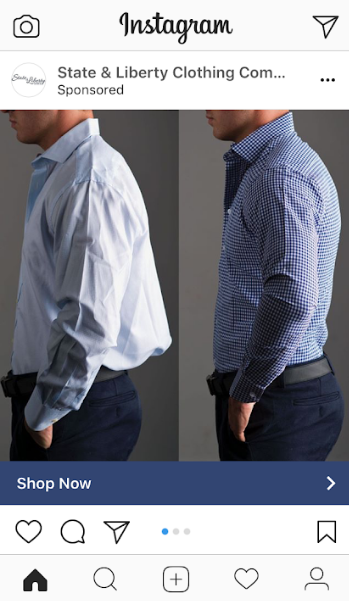
It’s very clear what the carousel ad is trying to convey.
Same model, two different shirts.
The shirt on the left looks messy, coming untucked. Many guys can relate to that.
But the shirt on the right looks great. It fits the model perfectly, which makes him look sharp.
Combining two images in one picture is much more effective than showing one shirt without anything to compare it to.
Once a user sees this, they may be interested enough to keep swiping through the rest of the carousel ad.
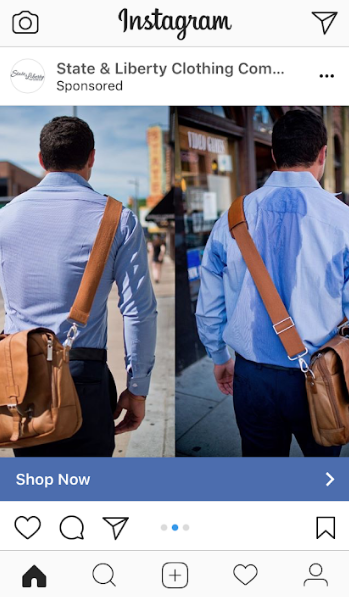
The next image of the ad uses the same strategy.
One shirt is neat, fits properly, and doesn’t cause the model to sweat. While the other shirt is messy, loose, coming untucked, and covered in sweat.
Even if the differences are embellished, that’s okay. It’s still an extremely effective way to promote the brand.
In just two pictures, this company is able to showcase how it differs from the competition by highlighting the top benefits of its product.
This campaign paired with an actionable CTA is a great way to drive sales.
Create a landing page that drives conversions
Your advertisement might be great.
You were able to pick the right marketing objective and target the perfect audience, and the content of your ad is getting people to click on your CTA.
However, all of this is useless if your landing page isn’t set up to drive conversions.
When a user clicks a CTA that says something like “shop now,” they shouldn’t land on your blog or homepage. You want to bring them directly to your ecommerce shop.
Make it easy for them to complete the checkout process with just a few clicks.
However, depending on your marketing goal, you can set up other types of landing pages to drive conversions, even if those conversions aren’t sales.
Check out this example of a landing page from Olivers Apparel:
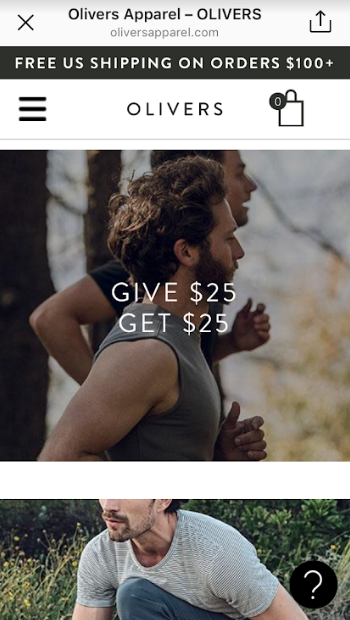
The company encourages users to recommend its brand to other people.
By sending $25 to a friend, they’ll get $25 in return. It’s a very enticing offer for a user exposed to a new brand for the first time.
You might be hesitant to spend money on a product you’ve never used before.
But $25 off your order may be a good enough reason for you to buy.
This strategy is a great example of a customer referral program that drives sales.
Let’s look at another landing page strategy from Buffy. You might want to consider using it in your marketing:
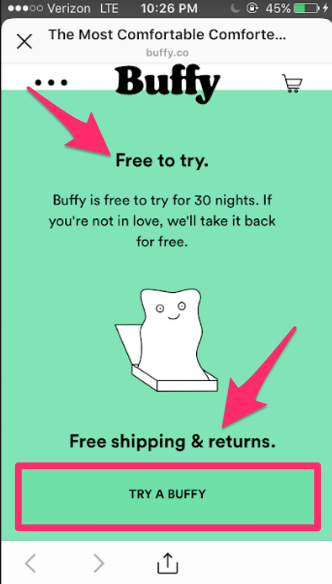
Instead of turning its prospective customers away with expensive prices, the brand’s landing page gives them an offer they can’t refuse.
You can try this product for 30 days at no cost.
They’ll ship it to you free, and if you’re not happy with it after a month, you can send it back—free too.
Instead of a CTA that says “buy,” the company used “try.”
Further, 30 days is plenty of time for prospective customers to decide whether they like the product or not.
Since Buffy offers such an enticing deal, I’m assuming the team is confident in the quality of its product, expecting the customers to be satisfied.
Sending Instagram users directly to your ecommerce shop is a great way to drive sales. But as you can see from these last two examples, you can use other types of landing pages that convert.
Highlight what makes your brand unique
This concept is similar to the idea of showing off your top benefits.
However, you and other brands may have similar benefits. If you can explain what makes your brand unique, you can have a competitive advantage.
For example, let’s say you sell athletic footwear. Some of its top benefits may be related to comfort, durability, style, and performance.
But does that really separate you from the crowd?
Something that makes your brand unique may be that a portion of your sales goes to a particular charity. That’s unique.
Here’s a more specific example from a Felix Gray Instagram ad:
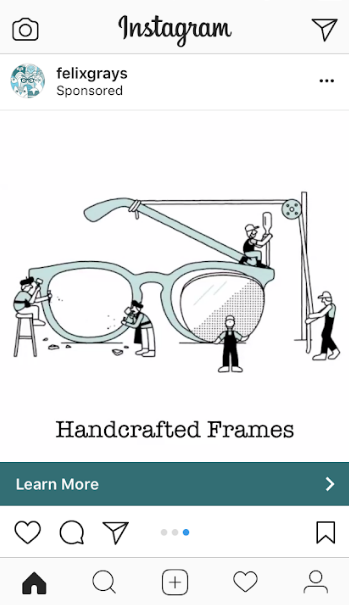
The company sells different types of glasses.
But does that make them unique? Not really.
However, this advertisement says that its frames are crafted by hand. That’s worth mentioning as part of a differentiation strategy.
Conclusion
Your company needs to have an Instagram marketing strategy.
While you can use Instagram free, running ads can give you the competitive advantage you’ve been looking for. This will help you target new customers outside of your existing followers.
Start by identifying your marketing objectives. Then, decide what audience you want to target with each campaign.
Choose which type of ad you want to run. Budget your ads accordingly.
Make sure your CTA is actionable.
Create an ad that showcases the top benefits of your products. Explain what makes your brand unique.
Design a landing page that drives conversions.
If you’re able to accomplish everything I’ve explained in this guide, your Instagram ads will be effective and profitable.
What types of ads is your brand using to drive sales on Instagram?
from Quick Sprout https://ift.tt/2O2JlwK
via IFTTT
